This article was co-authored by Joel Giffin, PT, DPT, CHT and by wikiHow staff writer, Christopher M. Osborne, PhD. Dr. Joel Giffin is a Doctor of Physical Therapy and the Founder of Flex Physical Therapy in New York, New York. With over 15 years of experience as a Certified Hand Therapist (CHT), Dr. Giffin treats the whole body and specializes in rehabilitation of the hand and upper extremities. He has treated Broadway theater performers backstage at shows such as The Lion King, Sleep No More, Tarzan, and Sister Act. Flex Physical Therapy also specializes in occupational and pelvic floor therapy. Dr. Giffin earned his Master’s degree in Physical Therapy with honors from Quinnipiac University and received his Doctor of Physical Therapy (DPT) degree with distinction from Simmons College. He is a member of the American Physical Therapy Association and the American Society of Hand Therapists.
There are 7 references cited in this article, which can be found at the bottom of the page.
This article has been viewed 80,161 times.
Wrist splints are often used by people dealing with carpal tunnel syndrome (CTS), rheumatoid arthritis (RA), and various other causes of wrist pain, stiffness, or weakness. They come in many shapes, sizes, and materials, but fall into two basic categories: resting splints and working splints. You should consult a medical professional to determine the best splint type for you, get the splint custom-fitted if possible, wear it only as much as is recommended, and make sure you know how to properly wear it and care for it.
Things You Should Know
- For carpal tunnel syndrome or rheumatoid arthritis, wear your wrist splint to bed at night.
- If you use a working splint, take breaks from your splint, get it custom-fitted, and even if your wrist starts to feel better, keep wearing your splint.
- To avoid skin conditions or muscle weakness, inspect your skin for redness and pick up a few lightweight items each time you remove your splint.
Steps
Wearing a Resting Splint for Limited Periods
-
1Wear a resting splint only as advised by a medical professional. Resting splints are usually made of a rigid, molded plastic material and are meant to completely immobilize your wrist in a neutral position. Your splint should relieve pain and swelling by supporting your hand and wrist in a neutral position. Resting splints are intended for use while sleeping or at rest.[1] However, you should see a physician, physical therapist, or certified hand therapist to determine if this is necessary and appropriate.[2]
- Under most circumstances, resting splints should be worn overnight while you sleep. Your doctor may recommend that you wear your splint sparingly during the day if you're experiencing flare-ups or have painful joints. Make sure you only wear it as recommended by your doctor.
- If you wear one for too long or too frequently, your wrist joint will stiffen up and the supporting muscles will weaken due to you not using them.
-
2Use a splint that is custom-fit to your wrist. Resting splints work best if the rigid material is molded to fit specifically over your unique wrist area. Your doctor, physical therapist, or another medical professional should be able to give you information on how and where to acquire a custom-fitted splint.[3]
- Splints that fit poorly won’t provide the right support and often lead to skin irritation and joint discomfort.
- Don’t wear a splint designed for someone else—it may do more harm than good.
Advertisement -
3Wear it nightly for at least a month to address CTS. If you have been diagnosed with carpal tunnel syndrome (CTS), your doctor’s first recommendation may be to wear a resting splint nightly for a month. Roughly one-third of CTS patients find that this treatment alone is enough to reduce their symptoms for at least a year.[4]
- It’s much easier to bend your wrist awkwardly (in ways that constrict the carpal tunnel in your wrist) for long periods during the night. This is often the primary contributor to CTS, even if you might assume it’s mostly due to working at a keyboard every day.
-
4Apply it nightly or during flare-ups to help manage RA. If you’re dealing with rheumatoid arthritis (RA), you may be advised to combine nightly use of a resting splint with daily use of a working splint during flare-ups.[5] Using only this combination for a month has been shown to reduce wrist pain in about one-third of RA sufferers.
- Don’t wear a resting splint all night and a working splint all day unless specifically advised to do so by your doctor, and do it only for as long as advised. Otherwise, you may cause further joint stiffness and muscle weakness.
- Always follow your doctor's or physical therapist's advice so that you heal well. This will help prevent muscle weakness.
Using a Working Splint as Needed
-
1Get your working splint custom-fitted if possible. Because working splints aren’t rigid and custom-molded like resting splints, it’s possible to find a model that fits and works fairly well either in stores or online. However, it’s still best to get the splint custom-fitted to your wrist by a medical professional if possible.
- At least consider buying a splint in-person at a medical supply store with employees who are willing and able to help you find the best off-the-shelf model for your needs.
- Some working splints have a flat metal insert that runs from the base of the palm up past the wrist. These can be bent by hand to fit the contours of your wrist more comfortably.
- A working splint will stabilize the joints in your hands and wrists.
-
2Don’t wear the splint all the time. Because they are made of various elastic materials that allow at least some freedom of wrist movement, working splints can easily be worn while doing most everyday activities. However, just as with resting splints, overuse of working splints can result in joint stiffness and muscle weakness over time, not to mention potential skin irritation.[6]
- If your doctor advises you to wear it daily for a month, ask about whether and how often you should remove it to loosen up your wrist joints and work the muscles.
- If you’re advised to wear it when doing activities that put strain on your wrist—yard work, moving furniture, etc.—only wear it during those times.
-
3Don’t stop splinting immediately upon feeling better. People are often over-eager to ditch their working splints, either because their wrist pain has subsided, they don’t like the reduction in wrist flexibility, or they simply dislike the look of the brace (and the questions they get about it). However, if your doctor has advised you to wear it for a month, for example, keep using it for that long.[7]
- Even if your wrist feels better, it still may be healing and susceptible to re-injury or re-aggravation.
- Wrist splints do come in many styles and colors if aesthetics are important to you.
-
4Consider getting two splints so you can switch them out. People sometimes stop wearing their wrist splints earlier than they should because they get dirty or begin to smell bad. While most splints can be surface-washed or possibly submerged and hand-washed, you may want to invest in 2 of them so you can rotate them when one needs cleaning.
- If you get 2 working splints, it’s best to get the exact same model with the exact same fit. You might be able to find different colors to coordinate with your wardrobe, though!
Applying and Checking on Common Wrist Splints
-
1Slide on the splint so it’s snug against your wrist and thumb. Whether it’s rigid or flexible, the inside of the splint should be snug against the base of your thumb, the base of your palm, and your wrist. Make sure you slide it up your lower arm until it makes contact with these areas.
- This is one reason why custom fitting is a good idea. That way, you know the splint will fit well in all the major contact points.
-
2Secure the Velcro straps from the splint’s top or bottom. For most rigid resting splints, it’s usually best to secure the top Velcro strap first (nearest the elbow), then work your way down. For flexible working splints, though, it may be best to start with the lowest (wrist-side) strap first, then work upward. The key is to keep the brace positioned properly while you secure it in place.[8]
- Virtually every model of wrist splint uses multiple Velcro (or similar hook-and-loop closure) straps to stay in place. It will have an attachment strip on the body of the splint, which should be made of elastic, neoprene, or synthetic rubber.
- Make the Velcro straps tight, but not uncomfortably so. If your fingers tingle or lose their normal color, the straps are definitely too tight.
- Ask a medical professional for a demonstration on putting the splint on.
-
3Check for skin irritation, joint stiffness, or muscle weakness. Every time you remove the splint, check your skin for any areas of significant redness, irritation, or even blistering. Also gently flex your wrist up, down, and around, and open and close your hand a few times, to gauge whether the joints have become stiff (or stiffer than before). Finally, pick up a few lightweight objects and evaluate whether you’ve developed any additional muscle weakness.[9]
- This is only general advice—follow your doctor’s instructions on how and how often to perform such checks, if at all.
- If you notice irritation, stiffness, or weakness, contact your doctor about possibly switching splints or altering when you wear one.
- It's important to keep your wrist as dry as possible, since moisture, including sweat, can cause blisters or skin damage. You may notice that your skin rubs off if you sweat often.
Expert Q&A
Did you know you can get expert answers for this article?
Unlock expert answers by supporting wikiHow
-
QuestionHow do I know if I need a wrist splint?
 Joel Giffin, PT, DPT, CHTDr. Joel Giffin is a Doctor of Physical Therapy and the Founder of Flex Physical Therapy in New York, New York. With over 15 years of experience as a Certified Hand Therapist (CHT), Dr. Giffin treats the whole body and specializes in rehabilitation of the hand and upper extremities. He has treated Broadway theater performers backstage at shows such as The Lion King, Sleep No More, Tarzan, and Sister Act. Flex Physical Therapy also specializes in occupational and pelvic floor therapy. Dr. Giffin earned his Master’s degree in Physical Therapy with honors from Quinnipiac University and received his Doctor of Physical Therapy (DPT) degree with distinction from Simmons College. He is a member of the American Physical Therapy Association and the American Society of Hand Therapists.
Joel Giffin, PT, DPT, CHTDr. Joel Giffin is a Doctor of Physical Therapy and the Founder of Flex Physical Therapy in New York, New York. With over 15 years of experience as a Certified Hand Therapist (CHT), Dr. Giffin treats the whole body and specializes in rehabilitation of the hand and upper extremities. He has treated Broadway theater performers backstage at shows such as The Lion King, Sleep No More, Tarzan, and Sister Act. Flex Physical Therapy also specializes in occupational and pelvic floor therapy. Dr. Giffin earned his Master’s degree in Physical Therapy with honors from Quinnipiac University and received his Doctor of Physical Therapy (DPT) degree with distinction from Simmons College. He is a member of the American Physical Therapy Association and the American Society of Hand Therapists.
Physical Therapist Ideally, you should see your physician, physical therapist, or certified hand therapist. They'll recommend one for you to use if it's appropriate. However, if you need to use something until you can get in to see your doctor, choose a splint that holds your wrist in a neutral position. Your wrist should feel more comfortable with the splint on—this isn't a "no pain, no gain" situation.
Ideally, you should see your physician, physical therapist, or certified hand therapist. They'll recommend one for you to use if it's appropriate. However, if you need to use something until you can get in to see your doctor, choose a splint that holds your wrist in a neutral position. Your wrist should feel more comfortable with the splint on—this isn't a "no pain, no gain" situation.
Warnings
- When you're wearing a wrist splint, it should hold your wrist in a neutral position, and it should not cause you any pain.[10]⧼thumbs_response⧽
References
- ↑ https://www.uhs.nhs.uk/Media/UHS-website-2019/Patientinformation/Medicinestherapiesandanaesthetics/Restingsplints-1820-PIL.pdf
- ↑ Joel Giffin, PT, DPT, CHT. Physical Therapist. Expert Interview. 22 October 2020.
- ↑ https://my.clevelandclinic.org/health/drugs/15211-casts--splints
- ↑ https://www.ncbi.nlm.nih.gov/books/NBK279596/
- ↑ https://www.ncbi.nlm.nih.gov/pmc/articles/PMC6330686/
- ↑ https://orthoinfo.aaos.org/en/recovery/care-of-casts-and-splints/
- ↑ https://www.aafp.org/pubs/afp/issues/2007/0201/p342.html
- ↑ https://orthoinfo.aaos.org/en/recovery/care-of-casts-and-splints/
- ↑ https://www.aafp.org/pubs/afp/issues/2007/0201/p342.html
- ↑ Joel Giffin, PT, DPT, CHT. Physical Therapist. Expert Interview. 22 October 2020.
About This Article
A wrist splint can help with carpal tunnel, arthritis, and other wrist pains. Remember to follow your doctor's instructions for how often to wear your wrist splint so you don’t stiffen your joints. If your doctor gives you a custom-molded resting splint, use it while you’re sleeping or if you experience a flare-up during the day. If you’re given a working splint, wear it during most everyday activities, but take it off regularly throughout the day to give your wrist a break. Keep using it for as long as your doctor advises, even if your wrist stops hurting. Make sure your wrist splint is tight but not uncomfortable. You don’t want to cut off the blood supply to your hand. For more tips from our Medical co-author, including how to get your wrist splint custom-fitted, read on.


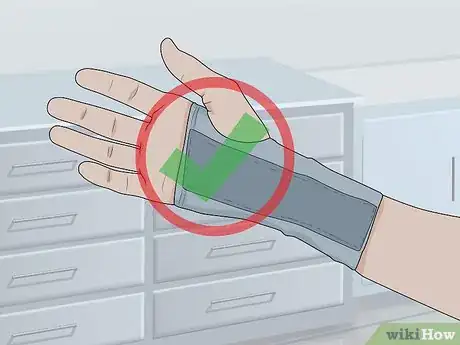

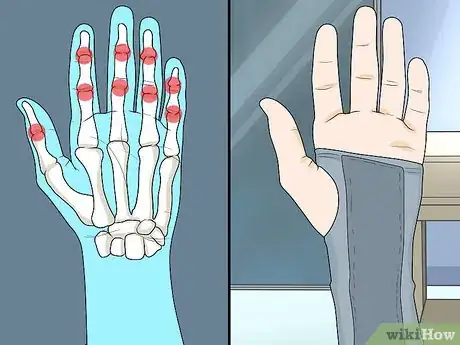

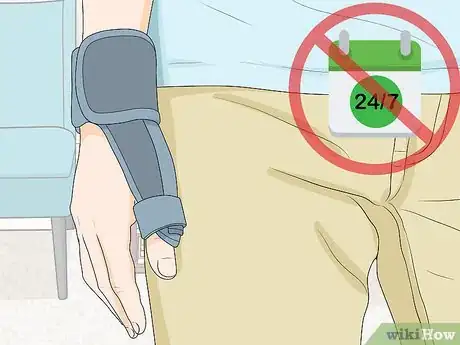
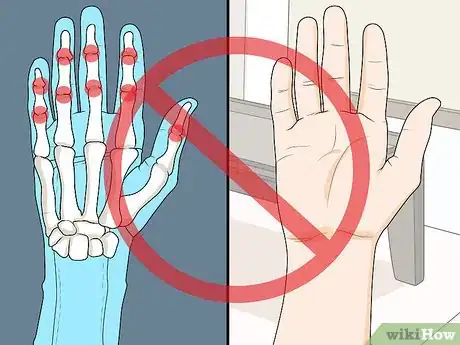

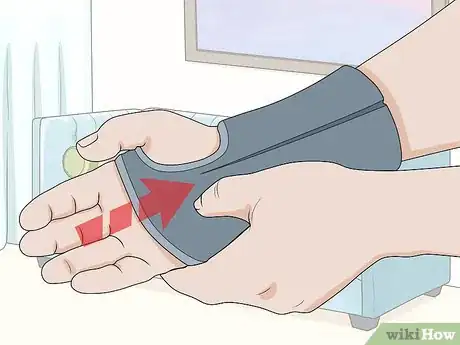


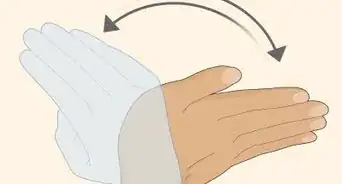
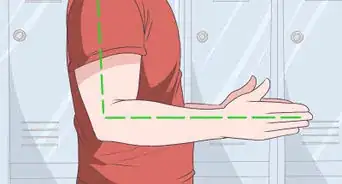
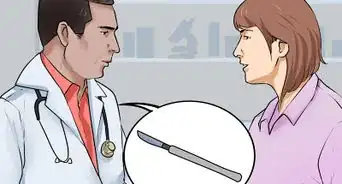




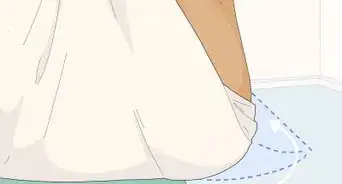
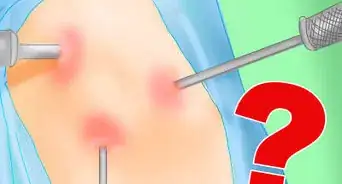
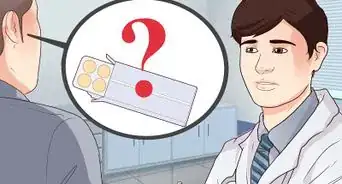













































Medical Disclaimer
The content of this article is not intended to be a substitute for professional medical advice, examination, diagnosis, or treatment. You should always contact your doctor or other qualified healthcare professional before starting, changing, or stopping any kind of health treatment.
Read More...